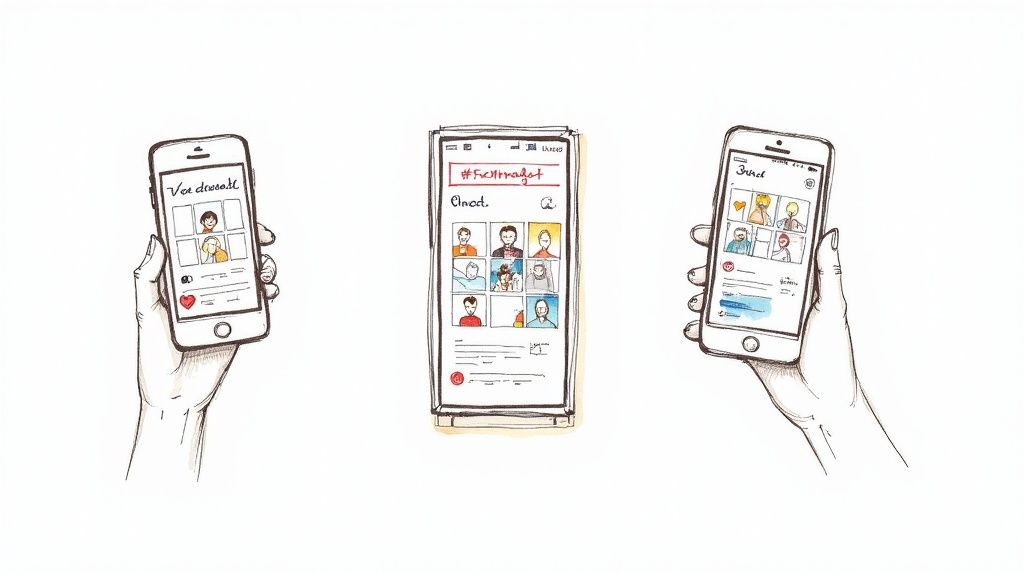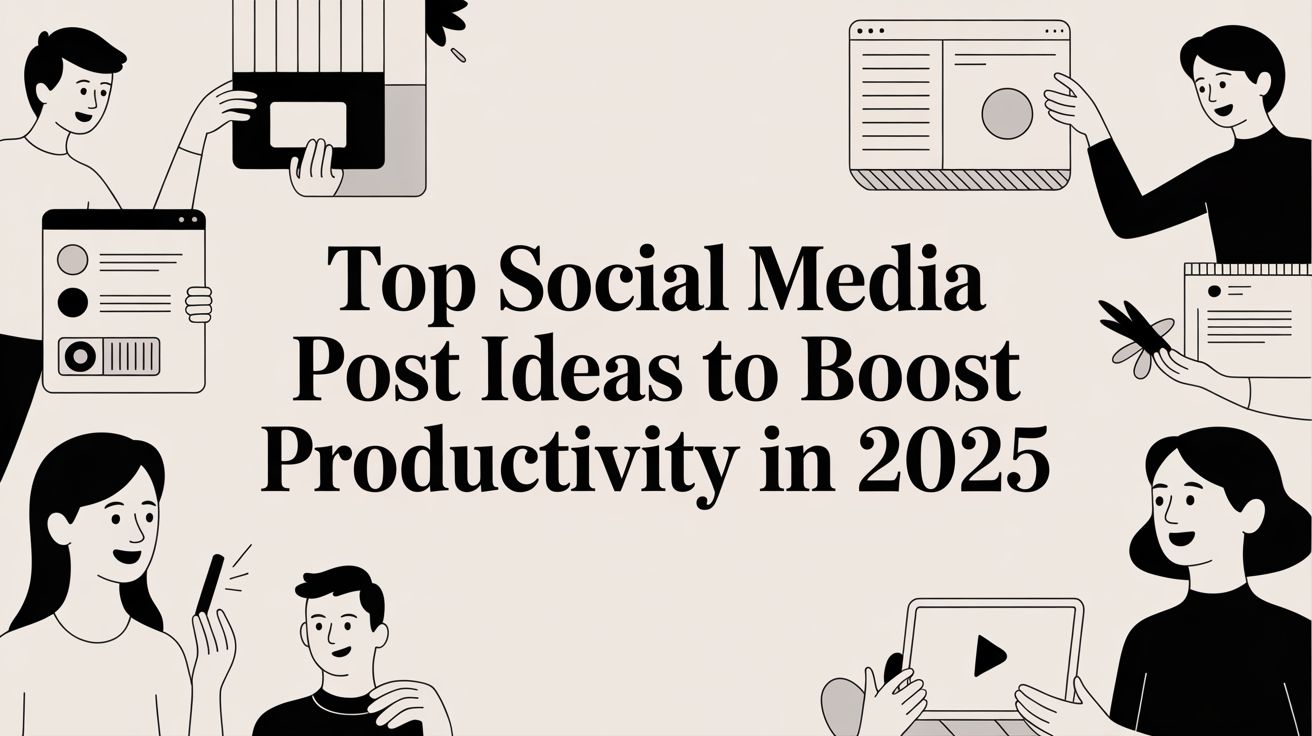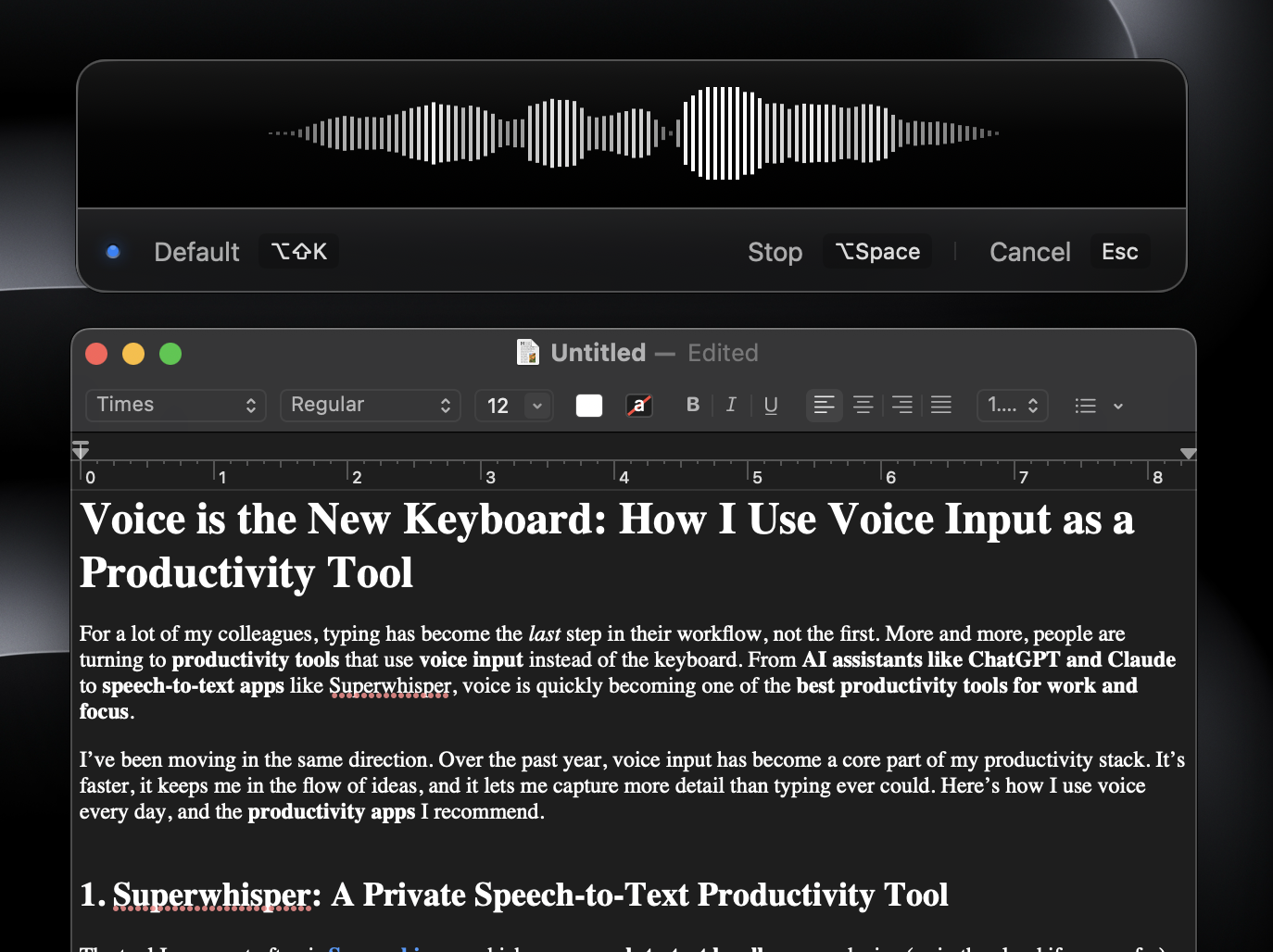This article was assisted with AI. We may include links to partners.
For founders and small business owners, the pressure to create consistent, engaging social media content can be overwhelming. Staring at a blank content calendar often feels like a productivity black hole, draining valuable time and energy that could be spent elsewhere in the business. This guide cuts through that noise.
We are providing a practical, battle-tested list of 12 specific social media post ideas designed not just to fill your feed, but to streamline your workflow and drive real results. Forget generic advice; each idea is packed with actionable tips, practical examples, and productivity-focused workflows to help you create better content, faster. You’ll learn exactly how to leverage different content formats to build a genuine community, establish your authority, and connect with your audience on a deeper level.
Our goal is to turn content creation from a chore into a powerful, efficient growth engine for your business. To further revolutionize your workflow and generate even more social media post ideas, you can explore various resources like these excellent AI Tools for Content Creation that help automate and inspire your process. Let’s dive in and end the blank page panic for good.
1. Behind-the-Scenes Content
Pulling back the curtain humanizes your brand, transforming it from a faceless entity into a relatable group of people. This social media post idea is all about showing the unfiltered, authentic work that goes into your products or services. By revealing your process, workspace, and team, you build trust and foster a deeper connection with your audience, making them feel like insiders.

This approach is highly effective because it satisfies audience curiosity and demonstrates transparency. When customers see the effort, care, and even the occasional happy accident that occurs, they develop a stronger appreciation for your final offering.
How to Implement Behind-the-Scenes Content
- Show Your Process: A bakery could post a time-lapse of a cake being decorated. Productivity tip: Batch record several short process videos in one session and schedule them out over the month.
- Introduce Your Team: Create a weekly “Meet the Team” feature. Practical example: A software company can post a photo of a developer with a quote about the project they’re most passionate about. This puts a human face to your brand.
- Showcase Your Workspace: Post a quick panoramic video of your office or workshop. Practical example: A furniture maker could do a short tour of their woodshop, highlighting a favorite tool.
- Reveal Both Successes and Challenges: Share a story about a packaging design that didn’t work out. Productivity tip: Keep a running list of “learning moments” in a shared document. When you need content, pull a story from the list. This makes your journey more relatable.
2. User-Generated Content (UGC) Campaigns
Leveraging content created by your customers is one of the most powerful and productive social media post ideas. A User-Generated Content (UGC) campaign encourages your audience to share photos or videos featuring your products. This strategy transforms satisfied customers into brand advocates, building powerful social proof and populating your content calendar with authentic material.

This approach is highly effective because it provides trustworthy endorsements that are more impactful than traditional advertising. Seeing real people use and love your products builds immediate credibility and fosters a strong sense of community around your brand.
How to Implement UGC Campaigns
- Create a Unique Hashtag: Launch a campaign with a clear, memorable hashtag. Practical example: A fitness apparel brand could use #MyBrandWorkout to collect customer photos at the gym.
- Incentivize Participation: Encourage submissions by offering a prize, like a gift card or a feature on your official page. Practical example: Starbucks’ annual #RedCupContest gives a large gift card to the winners, generating thousands of posts.
- Feature the Best Submissions: Regularly repost and celebrate your favorite customer posts (with permission). Productivity tip: Use a tool like Trello or a dedicated folder to save and organize approved UGC submissions so you always have content ready to post.
- Make It Simple: Ensure the rules for entry are straightforward. Complicated processes deter participation. Workflow: Post the rules clearly in your bio link and mention it in every campaign-related post.
3. Educational and How-To Content
Providing your audience with valuable information establishes your brand as a trusted authority. This social media post idea centers on teaching, guiding, and solving problems for your followers. By sharing tips and step-by-step guides, you deliver genuine utility that builds loyalty and keeps your audience coming back for more.
This strategy is powerful because it directly addresses your audience’s pain points. When you consistently help people learn a new skill, you create a strong, positive association with your brand that transcends simple product promotion.
How to Implement Educational and How-To Content
- Create Step-by-Step Carousels: Use Instagram carousels to break down a complex process. Practical example: A financial advisor could create a carousel on “5 Steps to Building Your First Budget,” with each slide detailing one action.
- Film Quick Tip Videos: Record short, vertical videos (like Reels or Shorts) demonstrating a single, impactful tip. Productivity tip: Dedicate a two-hour block to film 5-10 quick tip videos at once. This “batching” method stocks your content calendar for weeks.
- Offer Downloadable Guides: Create a valuable resource like a checklist and offer it as a free download. Workflow: Use a tool like Canva to design a simple PDF template you can quickly update for new guides, saving design time.
- Host “Ask Me Anything” Sessions: Use live video or a Stories Q&A sticker to position yourself as an expert. Explore content repurposing strategies to turn these sessions into future posts by screenshotting the best questions and turning them into individual posts later.
4. Polls and Interactive Questions
Directly asking your audience for their opinion is one of the most effective social media post ideas for sparking immediate interaction. Polls and questions transform passive scrolling into active participation. This strategy not only boosts your engagement rates but also serves as a powerful, informal market research tool.
This approach is highly valuable because it lowers the barrier to entry for engagement. The insights you gain can directly inform your content strategy and product development. Understanding the nuances of social media engagement is key to maximizing these interactions.
How to Implement Polls and Interactive Questions
- Ask “This or That” Questions: A coffee shop could post a poll on Instagram Stories asking, “Iced Latte or Cold Brew?” This is simple, quick, and provides direct preference data.
- Run a Weekly Q&A: Use Instagram’s “Ask me a question” sticker to host a weekly Q&A session. Productivity tip: Announce the Q&A in the morning, collect questions all day, and then answer the top 5-10 in a batch session in the evening.
- Crowdsource Ideas: Ask your audience to help you make a business decision. Practical example: A new restaurant could create a Twitter poll asking, “What dish should we feature on our launch menu?” This makes your audience feel invested.
- Create Quizzes and Contests: To specifically leverage interactive elements, explore various creative social media contest ideas. Workflow: Use a simple tool like Typeform or Google Forms to build a quiz and link it in your bio for easy access.
5. Storytelling and Personal Narratives
Facts tell, but stories sell. This social media post idea centers on weaving compelling narratives about your brand’s origins, values, or customer journeys. Narrative-driven content creates an emotional resonance that facts and figures alone cannot, helping your audience connect with your brand on a deeply human level.

This approach is powerful because it transforms your brand from a simple provider of goods or services into a character in your audience’s life. When people emotionally invest in your story, they build loyalty that transcends price or features.
How to Implement Storytelling and Personal Narratives
- Share Your Origin Story: Detail the “why” behind your business. Productivity tip: Write your core origin story once, then break it into 3-4 smaller posts (the problem, the idea, the launch) to create a mini-series.
- Highlight Customer Journeys: Feature a customer’s success story. Workflow: Create a simple email template requesting a testimonial. When you receive a great one, ask for permission to feature it as a story post.
- Tell a “Day in the Life” Story: Use a series of Instagram Stories to document a typical day from an employee’s perspective. Practical example: A non-profit could show a volunteer’s day, from setup to interacting with the community.
- Narrate a Product’s Creation: Document the journey from initial sketch to final prototype. Practical example: An artist could show timelapse videos of a painting being created, with captions explaining their inspiration for each stage.
6. Trending Audio and Sound-Based Content
Leveraging trending audio taps into the cultural pulse of social media, making your brand feel current and relevant. This social media post idea involves using popular songs or sound clips in your video content. By doing so, you can significantly increase your content’s discoverability as platforms like TikTok and Instagram prioritize videos that use trending sounds.
This strategy works because it instantly makes your content more engaging. Users are already familiar with the sound, creating an immediate connection. It’s a powerful way to join a larger conversation and show that your brand understands and participates in current online culture.
How to Implement Trending Audio Content
- Adapt Trends to Your Niche: Find a trending sound and apply it to a problem specific to your industry. Practical example: A financial advisor could use a popular audio clip about “making a bad decision” to illustrate a common investing mistake.
- Monitor ‘For You’ Pages: Regularly spend time scrolling through TikTok’s “For You” page. Productivity tip: When you hear a sound you like, save it to your “Favorites” immediately. Then, dedicate one hour per week to review your saved sounds and create content.
- Enhance Storytelling: Use a sound to set the mood or provide comedic timing. Practical example: A coffee shop could use a dramatic, suspenseful sound for a video that builds up to the reveal of a new seasonal latte.
- Act Quickly: Trends have a short lifespan. Workflow: When you spot a sound that aligns with your brand, aim to create and post your version within 48 hours to capitalize on its peak popularity.
7. Carousel Posts (Multi-Image/Slide Format)
Carousel posts are a powerful social media post idea that bundles multiple images or videos into a single, swipeable experience. This format is perfect for storytelling, breaking down complex information, or showcasing a product from multiple angles. It actively encourages user interaction, boosting engagement as followers swipe to see what’s next.
This format excels because it holds user attention longer than a single image, increasing the likelihood that your message will be absorbed. By guiding your audience through a sequence, you can create a more comprehensive and impactful narrative.
How to Implement Carousel Posts
- Create Step-by-Step Guides: A fitness coach can use a carousel to demonstrate a multi-step exercise. Practical example: Skincare brand Sephora could show a morning routine, with each slide representing a different product and step.
- Showcase Product Features: Use each slide to highlight a different feature of a product. Practical example: Airbnb effectively uses carousels to showcase various rooms and amenities of a single property.
- Tell a Story or Share a Process: A coffee shop could use a carousel to walk followers through the bean-to-cup journey, from green beans to final latte art.
- Repurpose Existing Content: Turn a short blog post into a visually engaging carousel. Productivity tip: Use an AI summary tool to extract the key points from a blog, then dedicate one carousel slide to each point. This creates a new piece of content in minutes.
8. Memes and Humor-Based Content
Leveraging humor makes your brand more human and approachable. This social media post idea revolves around creating or sharing lighthearted, funny, and relatable content. When done right, memes and jokes foster a sense of community, boost engagement, and make your brand memorable.
This strategy is powerful because it taps into the primary reason many people use social media: entertainment. Funny content is also highly shareable, which can dramatically expand your organic reach far beyond your existing followers.
How to Implement Memes and Humor-Based Content
- Use Relatable Industry Humor: A marketing agency could use the “Distracted Boyfriend” meme to show a business owner being tempted by a new social media trend while ignoring their proven strategy.
- Create Brand-Centric Jokes: A coffee shop could post a meme about the difference between a person before and after their morning coffee. This directly connects the humor to the product.
- Stay Current with Trends: Capitalize on viral meme formats quickly. Productivity tool: Use a tool like Canva’s meme generator to easily add your own text to popular templates without needing complex design software.
- Maintain a Balance: Humor should be a part of your content mix, not all of it. Workflow: Plan for one humor-based post per week to keep your feed light without undermining your brand’s authority.
9. Live Streaming and Real-Time Events
Broadcasting live video creates an unparalleled sense of urgency and direct connection. Live streams offer an unscripted, real-time window into your brand, allowing for genuine interaction. This format is perfect for building community, launching products, and hosting engaging events that make your audience feel part of something exclusive.
This approach is highly effective because it fosters immediate engagement and transparency. Unlike pre-recorded videos, live content is raw and interactive, which helps build trust. Viewers can influence the broadcast with their comments, creating a dynamic experience.
How to Implement Live Streaming and Real-Time Events
- Host a Live Q&A Session: Announce a live Q&A with a founder or expert. Productivity tip: Use the Instagram “Questions” sticker in your stories 24 hours before the live stream to pre-collect questions. This ensures you have content ready and won’t have awkward silences.
- Launch a Product Live: Build anticipation for a new release with a live launch event. Practical example: A fashion brand could use Facebook Live to unveil a new collection, showcasing models and answering questions about sizing.
- Stream an Event or Workshop: If you’re hosting an in-person event, stream a portion of it live. This extends your reach and provides value to those who couldn’t attend.
- Go Behind the Scenes Spontaneously: Start a quick, unscripted live stream showing a normal day at the office. Workflow: Keep it short (5-10 minutes) to minimize disruption to your workday while still providing authentic content.
10. Data Visualizations and Infographics
Transforming complex data into visually appealing graphics makes your information digestible and highly shareable. This social media post idea establishes your brand as a knowledgeable authority by presenting statistics and trends in an engaging, easy-to-understand format. By simplifying dense information, you provide immense value to your audience.
This approach is powerful because it positions your business as a go-to resource. When followers see you consistently publishing insightful, well-researched data, they learn to trust your expertise, which is a critical step in converting them into customers.
How to Implement Data Visualizations and Infographics
- Create Simple Charts and Graphs: Use tools like Canva or Venngage to turn a single, compelling statistic into a clean bar graph. Practical example: A real estate agent could share a chart showing local home price trends over the last quarter.
- Design Mini-Infographics: Break a larger topic into 3-5 key data points and present them in a vertical, mobile-friendly graphic. Practical example: A fitness coach could create an infographic on “5 Surprising Statistics About Hydration.”
- Visualize Survey Results: If you’ve surveyed your audience, turn the most interesting findings into a shareable graphic. Productivity tip: Create a branded template for charts and graphs. This allows you to quickly plug in new data without redesigning from scratch every time.
- Highlight Key Takeaways: Don’t just show the data; tell your audience what it means. Workflow: Start your caption with the single most surprising insight from the graphic to immediately hook the reader.
11. Influencer Collaborations and Takeovers
Partnering with influencers leverages their established trust to introduce your brand to a new, engaged audience. This social media post idea involves having a creator produce content for your brand or temporarily manage your account, providing a fresh perspective and powerful third-party validation. It adds instant credibility and can significantly expand your visibility.
This strategy is effective because it taps into the authentic connection an influencer has with their community. A recommendation from a trusted voice is often perceived as more genuine than a traditional advertisement, making it a highly persuasive way to build brand awareness.
How to Implement Influencer Collaborations and Takeovers
- Plan a Themed Takeover: Invite an industry expert to take over your Instagram Stories for a day. Practical example: A fitness brand could have a nutritionist host a Q&A session about healthy eating, providing value to your audience.
- Co-Create Content: Work with a creator to produce a joint piece of content. Practical example: A coffee company could partner with a food blogger to develop and share a unique recipe using their beans, cross-promoting on both accounts.
- Sponsor a Product Review: Send your product to a micro-influencer whose niche aligns with your target customer. Ask for an honest video review showcasing how they use it.
- Run a Joint Giveaway: Collaborate with an influencer on a giveaway where participants must follow both accounts. Productivity tip: Use a third-party tool like Gleam or RafflePress to manage entries and automatically select a winner, saving you significant administrative time.
12. Limited-Time Offers and Urgency-Driven Posts
Creating a sense of urgency is a powerful psychological trigger that encourages immediate action. This social media post idea leverages the fear of missing out (FOMO) by promoting time-sensitive offers or flash sales. By setting a clear deadline, you prompt followers to stop scrolling and start converting, turning passive interest into active purchases.
This approach is highly effective for driving short-term sales and clearing inventory. When customers see a countdown or a “last chance” message, their decision-making process accelerates. This tactic transforms your social media feed from a simple content stream into a direct sales channel.
How to Implement Limited-Time Offers
- Launch a Flash Sale: Announce a 24-hour sale on a specific product. Use bold graphics and clear captions like, “25% off all graphic tees, today only! Link in bio.”
- Use Countdown Timers: Instagram and Facebook Stories have interactive countdown stickers. Use them to build anticipation or show how much time is left on a current offer.
- Create Scarcity: Frame posts around limited availability. Practical example: “Only 10 left in stock! Once they’re gone, they’re gone forever.” This works well for unique items.
- Build Anticipation First: Tease an offer for a few days. Workflow: Schedule a series of posts: 1) Announcement of a sale coming soon. 2) 24-hour reminder. 3) “Sale is now live!” post. This multi-step approach maximizes visibility and impact.
Comparison of 12 Social Media Post Ideas
| Content Type | Implementation 🔄 | Resources ⚡ | Expected outcomes 📊 | Ideal use cases 💡 | Key advantages ⭐ |
|---|---|---|---|---|---|
| Behind-the-Scenes Content | Medium — ongoing cadence and transparency required | Low–Medium — basic camera, time, team access | Higher engagement, stronger brand loyalty | Humanize brand; product/process reveals; recruitment | Authenticity, low production cost, emotional connection |
| User-Generated Content (UGC) Campaigns | Medium — campaign setup, moderation, rights management | Low–Medium — incentives, moderation tools, legal review | Increased reach, social proof, higher conversions | Launches, community building, awareness drives | Cost-effective scale, trust via real customers |
| Educational and How-To Content | High — research, clear structure, expertise needed | Medium–High — subject experts, production or design time | Thought leadership, organic reach, lead generation | Onboarding, SEO content, nurture sequences | Long-term value, authority, shareability |
| Polls and Interactive Questions | Low — simple to create but needs follow-up | Low — minimal production, scheduling | Quick feedback, spike in engagement, audience insights | Market research, A/B testing, Stories engagement | Fast insights, boosts time-on-content and algorithms |
| Storytelling and Personal Narratives | Medium — strong writing and authentic sourcing required | Medium — interviews, editing, occasional video | Emotional connection, memorability, loyalty growth | Brand origins, customer journeys, value-driven campaigns | Deep resonance, brand differentiation, shareability |
| Trending Audio and Sound-Based Content | Low–Medium — rapid turnaround to catch trends | Low — access to platform audio/library and editing | Improved discoverability and completion rates | Short-form video, youth-focused campaigns, virality attempts | Algorithmic reach, relevance, easy trend adoption |
| Carousel Posts (Multi-Image/Slide) | Medium — needs multiple cohesive assets and sequencing | Medium — design, copy, images/videos | Higher engagement and dwell time; clearer storytelling | Tutorials, product comparisons, multi-step messaging | Detailed storytelling, increased engagement per post |
| Memes and Humor-Based Content | Low — fast creation but timing-sensitive | Low — minimal tools; cultural awareness required | High shareability and brand personality growth | Light-touch engagement, audience rapport, timely posts | Low cost, viral potential, strengthens voice (if on-brand) |
| Live Streaming and Real-Time Events | High — technical setup and scheduling; live moderation | Medium–High — streaming gear, hosts, promotion | Real-time interaction, urgency-driven conversions | Product launches, Q&A, event coverage, live shopping | Immediate engagement, authenticity, FOMO-driven action |
| Data Visualizations and Infographics | Medium–High — data analysis and polished design | Medium–High — analysts, designers, tools | Credibility, shareability, improved retention and backlinks | Reports, industry insights, complex-data communication | Clarifies complexity, builds authority, high visual impact |
| Influencer Collaborations and Takeovers | Medium–High — partner selection, contracts, alignment | Medium–High — fees, coordination, measurement | Rapid audience reach, credibility boost, content variety | New audience acquisition, product endorsements, launches | Access to established audiences, authentic endorsements |
| Limited-Time Offers and Urgency Posts | Medium — campaign timing and inventory coordination | Medium — promotional budget, tracking, customer support | Immediate sales uplift and higher CTRs | Flash sales, clearance, event-driven promotions | Drives conversions quickly, creates excitement and urgency |
Turn Your Ideas Into a Consistent Social Presence
You now have a comprehensive toolkit of social media post ideas designed to engage, educate, and convert your audience. We’ve explored everything from authentic behind-the-scenes glimpses and powerful user-generated content campaigns to data-driven infographics and interactive live streams. Each of these twelve concepts offers a unique way to connect with your community and build your brand’s narrative.
The real challenge, however, isn’t a lack of ideas; it’s the consistent execution required to turn those ideas into tangible results. As a founder or small business owner, your time is your most valuable asset. The daily pressure to create, schedule, and publish content can quickly lead to burnout, inconsistency, and a social media presence that feels more like a chore than a strategic advantage.
From Inspiration to Implementation: Your Actionable Next Steps
To avoid the content creation treadmill, you need to build a system. This system should transform your inspiration into a reliable, high-quality content pipeline that works for you, even when you’re focused on other critical business tasks. Here’s how to get started:
Select Your Core Pillars: Don’t try to implement all twelve ideas at once. Choose 3-4 content “pillars” that align best with your brand’s personality and your audience’s interests. For example, a B2B service might focus on Educational Content, Data Visualizations, and Storytelling, while a D2C product brand might lean into UGC, Behind-the-Scenes, and Limited-Time Offers.
Create a Simple Content Calendar: Map out your chosen pillars across a weekly or monthly calendar. Assign a specific type of post to each day. This simple structure eliminates the daily “what should I post?” dilemma and ensures a balanced, engaging feed. For instance:
- Monday: Educational Carousel
- Tuesday: Interactive Poll
- Wednesday: Behind-the-Scenes Story
- Thursday: User-Generated Content Feature
- Friday: Humor-Based Meme
Batch Your Content Creation: Dedicate a specific block of time each week or month to create all your content at once. During this “batching” session, write your captions, design your graphics, and edit your videos. This is far more efficient than creating content on the fly each day.
The Power of a Streamlined Workflow
Ultimately, the goal is not just to have a list of social media post ideas but to build a sustainable workflow that fuels your growth. By systematically applying these concepts, you move from reactive posting to proactive brand-building. A consistent, high-value social media presence establishes credibility, fosters community, and drives business outcomes without consuming all of your creative energy. The key is to stop thinking post-by-post and start building a strategic, efficient content engine.
Ready to turn these ideas into a powerful, automated content schedule? Postful is an AI-powered social media tool designed for busy founders that helps you generate high-quality content from templates and automate your entire workflow. Join the Postful waitlist and start building a more impactful social presence in a fraction of the time.

